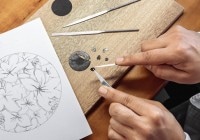
Search in Issues
Chapters
List of parts
Chapter 7
Bathyscaphe Times three
Three new Bathyscaphes offering useful complications with no dilution of their sport diving heritage.
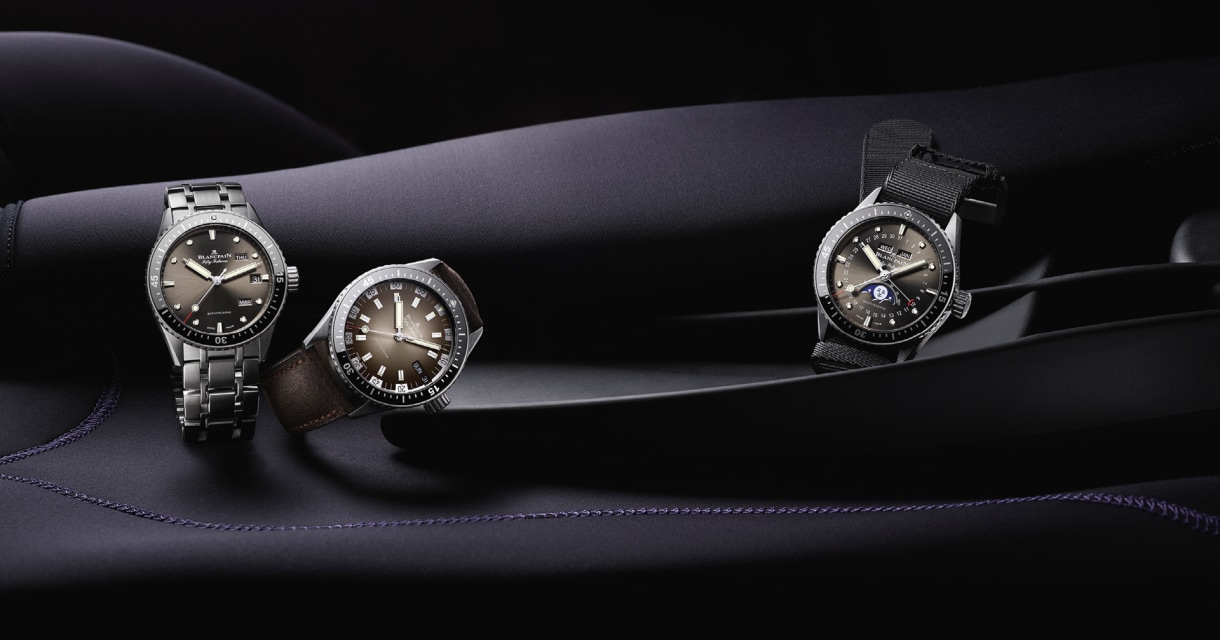
In the 1950s Blancpain conceived of the BATHYSCAPHE as an EVERYDAY timepiece that could be used for diving as well.
When Blancpain’s CEO Jean-Jacques Fiechter developed the first versions of what now is the iconic Fifty Fathoms, he had one mission in mind: creating a hard-core dive timing instrument. Two groups were his focus. First were amateur divers. Remember though, scuba diving, particularly by amateurs,
was in its infancy in 1953 when the Fifty Fathoms debuted for the general public. Fiechter refers to diving during those early days as “a different world” from what we know today. This was in all respects, using current parlance, an extreme sport. Fiechter portrays the diving clubs he knew along the Côte d’Azur in France—he was a member of five of them—as “serious”. At least equally serious, likely more so, was the second group which he targeted, professional divers, most of whom were in the world’s militaries. They were seeking dive watches for combat missions.
With this vivid focus, the Fifty Fathoms was singularly purposeful. Its large size to enhance legibility; white luminous hands and markings against a black background for the same reason; locking rotating bezel to mark the start time of the dive by rotating the index to a position opposite the minute hand and to show the length of the dive by reading the minute hand on the bezel scale; patented systems for the rear case seal and crown seal; shielding from magnetic fields, as well as automatic winding, were all conceived to serve these demanding “serious” diving groups.
In these early days everyday wear was not considered at all. Among other things, the large size of the Fifty Fathoms, perfect to enhance its use in murky waters or at night on military missions, ran counter to the fashions of the day. Men’s watches at the time were 33mm or smaller in diameter; the Fifty Fathoms was over 40mm. Indeed, Captain Robert “Bob” Maloubier, head of the newly formed French Navy’s Combat Diving Corps and a decorated hero of Churchill’s wartime special forces group, the SOE, recalls their experience testing watches from LIP, a prospective French supplier. The watches, impossible to read, were in his words “roughly the size of a fingernail and had nice small white straps”. And they leaked. Badly. That experience led the French in 1953 to Blancpain, where they found the Fifty Fathoms to be perfect for their military missions and thus decided to adopt Blancpain as the French Navy’s dive watch.
In 1956, three years after the selection by the French Navy and the public debut for civilians of the Fifty Fathoms, Fiechter broadened his vision. He conceived of a watch that could be used both as an everyday timepiece and for diving as well. He called it the Bathyscaphe, named after fellow Swiss, Auguste
Piccard’s record-breaking deep-diving vessel. All but one of the key features that distinguished the Fifty Fathoms and which cemented its position as the world’s first modern diving watch carried over into the Bathyscaphe. The significant difference between the Fifty and the Bathyscaphe was size; the smaller diameter of the Bathyscaphe made it better suited as a daily wear timepiece. It also was better adapted for women divers whose smaller wrists called for a more modestly sized watch.
While reducing the diameter opened up the Bathyscaphe to a larger audience, that was only Fiechter’s first step. His second was understanding that as an everyday watch, its appeal would be enhanced by introducing date complications. Over Fiechter’s three-decade tenure at the helm of Blancpain, not only did he develop Bathyscaphes with a date window, but some that added a day of the week indication.
Fiechter’s notion of marrying useful everyday complications, while fully preserving diving pedigree, is alive and well at today’s Blancpain. In 2018, Blancpain debuted no less than three new Bathyscaphes, each offering useful complications with no dilution of the sport diving heritage.
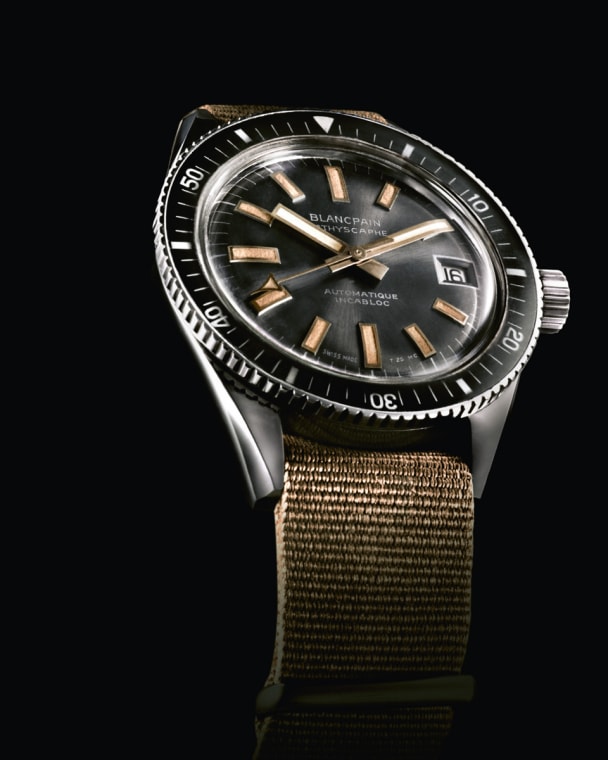
A 1950s vintage Bathyscaphe featuring a date complication.
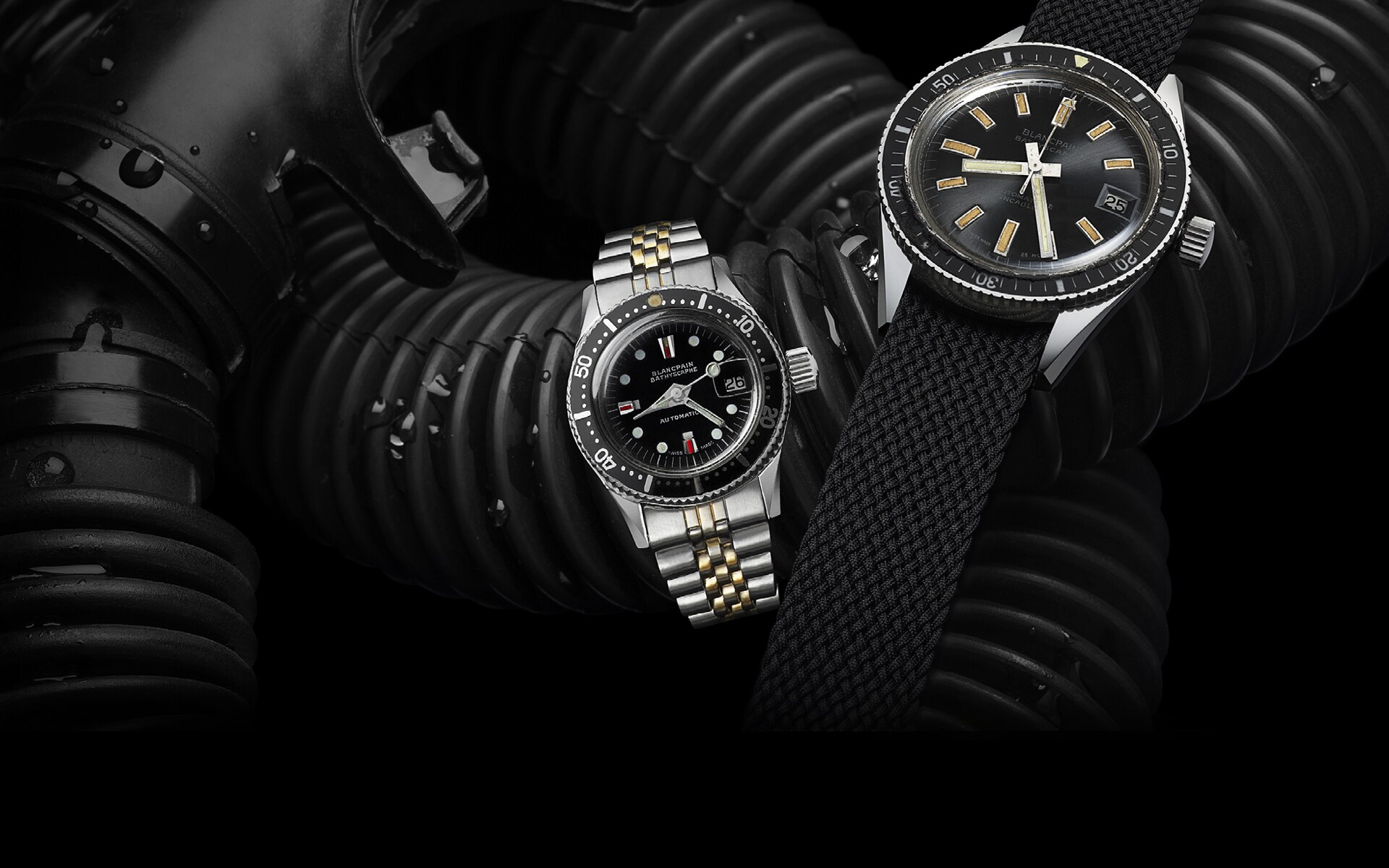

With the exception of the cushion-shaped case, ALL THE AESTHETIC CODES from the 1970s model Bathyscaphe have been carried over to TODAY’S DAY DATE 70S.
Bathyscaphe Day Date 70s
In the 1970s, Blancpain introduced a version of the Bathyscaphe that not only was complicated from the perspective of its day of the week/date calendar, but also leaned heavily toward the world of daily wear and 70s fashion with a cushion-shaped case and an internal rotating ring on the dial replacing the standard exterior rotating bezel. Its dial, likewise, yielded to contemporary tastes, as instead of the sober purposeful black of the Fifty Fathoms models, it was of a graduated gray color. It was this vintage Bathyscaphe that provided the inspiration for the new limited-edition Bathyscaphe Day Date 70s.
With the exception of the cushion-shaped case, all of the aesthetic codes from this 1970s model are respected in the new Bathyscaphe. The day of the week and date are displayed together at 3 o’clock, faithful to the original. Similarly, the graduated gray dial with its smoky hues carries over. The 1970s version replaced the exterior rotating bezel with a rotating ring located on the outer perimeter of the dial and controlled via a second crown. As an exterior rotating bezel is easier to use than an inner ring manipulated via a crown, the new model captures the look of the vintage ring with its bold tab indexes marking each five minutes, however, fixing the positions upon the dial. Timing of a dive, in common with all modern Fifty Fathoms and Bathycaphes, is accomplished with the external unidirectional rotating bezel featuring a ceramic insert with Liquidmetal® markings. The form of the hands and dial indexes is identical with the 1970s Bathyscaphe.
Of course, the movement of this vintage inspired new piece is thoroughly modern Blancpain, based upon the automatic winding in-house caliber 1315. This movement features three mainspring barrels to endow it with a five-day power reserve. The balance spring benefits from Blancpain’s pioneering work with silicon, a material that is not only a-magnetic and therefore resistant to magnetic fields, but which yields superior timing precision compared with pre-existing Nivarox balance springs. A collateral benefit from the use of silicon is that it dispenses with the need for a soft iron inner case to protect the balance spring from magnetism and allows, therefore, fitting the case with a transparent back. The gold winding rotor is colored with a NAC treatment (a platinum-based alloy) producing a dark gray color fitting to a sport watch.
The historical spirit of this 43mm diameter timepiece is reinforced with a vintage leather strap and a classic tang buckle. The Bathyscaphe Day Date 70s is limited to 500 pieces.
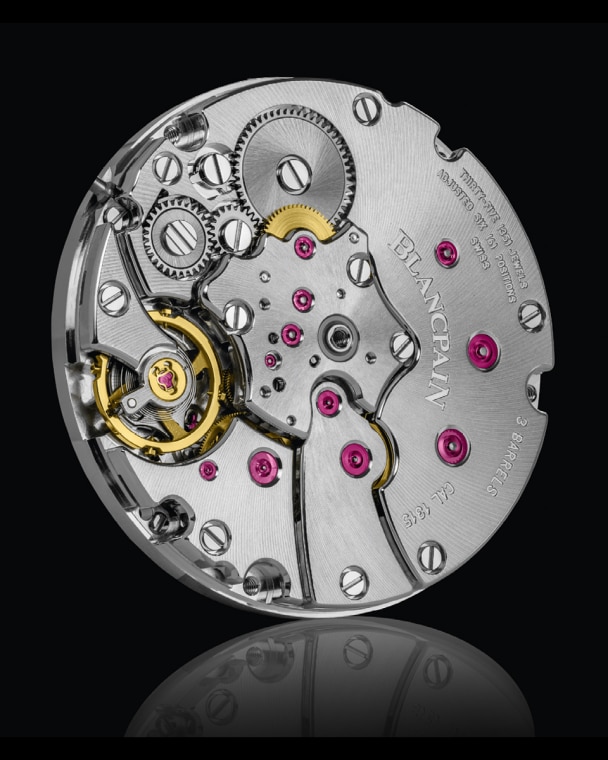
The caliber 1315 movement that powers the Day Date 70s.
The COMPLETE CALENDAR MOON PHASE is emblematic at Blancpain and is NOW EXPRESSED in the Bathyscaphe.
Bathyscaphe Quantième Complet The new Bathyscaphe Quantième Complet represents a marriage of two Blancpain signature icons. The first is of course the Bathyscaphe itself with its more than half-century history. Now that legacy is paired with Blancpain’s classic complete calendar moon phase
display with its own nearly forty-year heritage.
When the quartz crisis was at its most virulent peak, with floods of inexpensive quartz watches decimating the traditional Swiss mechanical watch houses, Blancpain was inspired to battle for survival not with cheapened timepieces competing on price with these quartz invaders, but with complications that embodied the values, feeling and spirit of fine watchmaking. Its first effort that debuted at the beginning of the 1980s was a complete calendar moon phase model. The display was utterly classical, with the day of the week and month shown in windows and the date upon a scale adjacent to the indexes shown with a supplemental hand. The phase of the moon was placed in a window at 6 o’clock. Aficionados of Blancpain are well-acquainted with this dial arrangement as it has become emblematic of the house and core to many models in both the Villeret and Women’s collections.
What better way to expand the everyday wear appeal of the Bathyscaphe than to incorporate this traditional calendar display? Since its introduction in the early 80s, the Blancpain calendar moon phase has undergone thorough modernization. One important change to the calendar plate that lies at the heart of the display is the new secured mechanism. Across the watch world, it is standard that complicated calendar displays cannot be set or adjusted during certain times of the day. With these designs, if a manual adjustment is attempted while the mechanism is in the middle of its daily date change, there is a substantial risk that the movement will be damaged. Thus, the industry-wide response to this risk is to warn users of the hours of the day when adjustment is forbidden. Blancpain was not satisfied with this approach, particularly since owners can easily confound the difference between 10 am, when an adjustment would not risk breakage, and 10 pm when the opposite would be true. Blancpain’s answer was the development of a secured calendar. It removes the risk of breakage, even if the manual setting or adjustment is done in the middle of an automated daily change. Whenever the owner commands an adjustment, the automatic daily change components are disengaged and fully protected against damage. To achieve this security, the complexity of the calendar is greatly increased, as many more components are required, but the benefits to the owner are enormous. The complete calendar moon phase used in the new Bathyscaphe is constructed following Blancpain’s pioneering design.
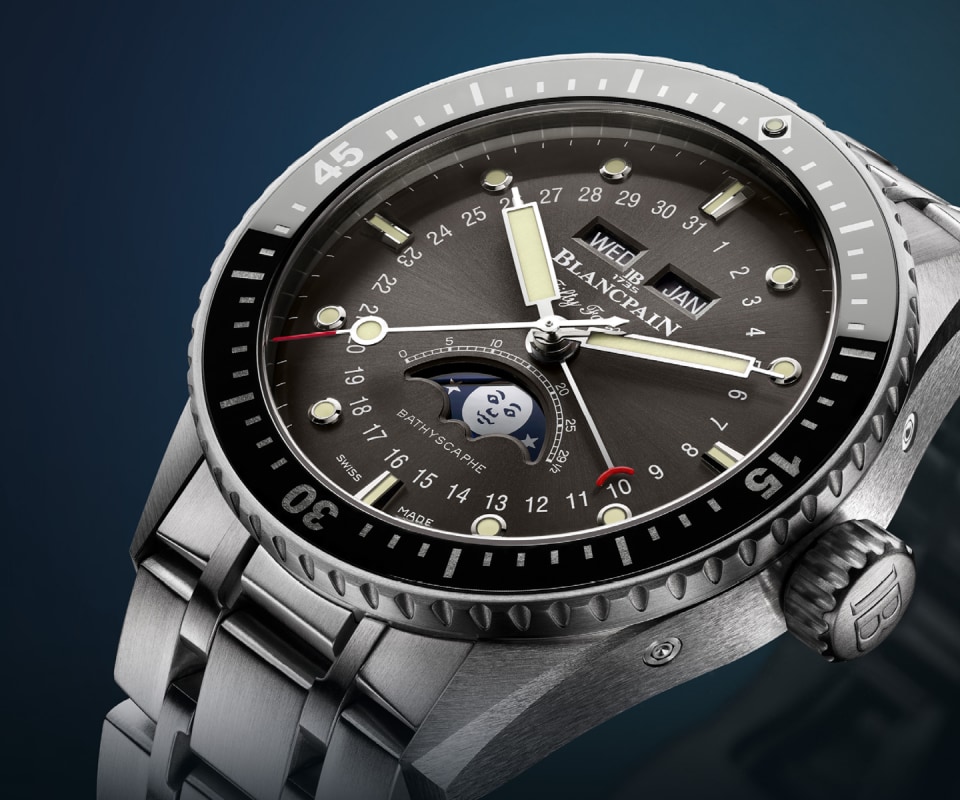
The calendar plate is powered by a version of Blancpain’s in-house 1150 caliber. This is a twin mainspring barrel movement offering a 72-hour power reserve. In common with the full range of Blancpain’s movements, the balance spring is made of silicon.
The other elements of the Bathyscaphe Quantième Complet hew to the core DNA of the Bathyscaphe collection. The diameter of the brushed stainless steel case is 43mm. It is fitted with a unidirectional rotating bezel with a ceramic insert and Liquidmetal® markings. The dial is black with luminous indexes and hands styled in common with the three-hand models. Sail cloth, NATO straps or a version with a stainless steel bracelet are all options.
The ANNUAL CALENDAR is one of watchmaking’s MOST PRACTICAL complications.
Bathyscaphe Quantième Annuel The annual calendar is one of watchmaking’s most practical complications. As it automatically accounts for all 30 or 31-day month variations, it closely approaches the full functionality of a perpetual calendar. Only one adjustment per year is required for an annual calendar and that occurs at the end of February, when the calendar must be advanced by the owner to the first of March. Apart from that one-time yearly intervention, the remainder of the yearly irregularities in the lengths of the months is fully programmed within and accounted for by the complicated mechanism of the annual calendar.
Not all annual calendars are created equal. Blancpain’s annual calendar design, now brought to the Bathyscaphe, has been endowed with a capability which makes it unique in the world of high watchmaking. The calendar automatically adjusts the date, day of the week, and, if appropriate, the month backwards when the time is adjusted backwards passing through midnight, an ability absent from all the other annual calendars produced in the industry. This sophisticated feature, which is no less than a complication additional to the annual calendar complication itself, is particularly valuable if the owner travels with his Bathyscaphe and wishes to reset the time in a backwards direction crossing through midnight.
The annual calendar also distinguishes itself in the logic of its display. The day of the week, date and month are all shown in windows located between the 2 o’clock and 4 o’clock positions on the dial. It is the order of the indications that sets it apart from others found in the watch world, for they are aligned as one would speak them “today is Thursday, the 31st of March”, in that order: day of the week at 2, date at 3, month at 4.
The other features and elements—base movement, case, size, dial color, hands, bezel, and strap choices—of the new Bathyscaphe Quantième Annuel are in common with the Quantième Complet. •

|
PUBLISHER EDITORIAL COMMITTEE PROJECT MANAGEMENT EDITORS IN CHIEF CONTRIBUTORS TO THIS ISSUE TRANSLATION PROOFREADING |
GRAPHIC DESIGN, LAYOUT ART DIRECTION PHOTOLITHOGRAPHY WATCH PHOTOGRAPHY OTHER PHOTOGRAPHY, ILLUSTRATIONS
Release date: February 2019 |

Other issues
Don't miss the latest issue
Sign Up for New Releases


